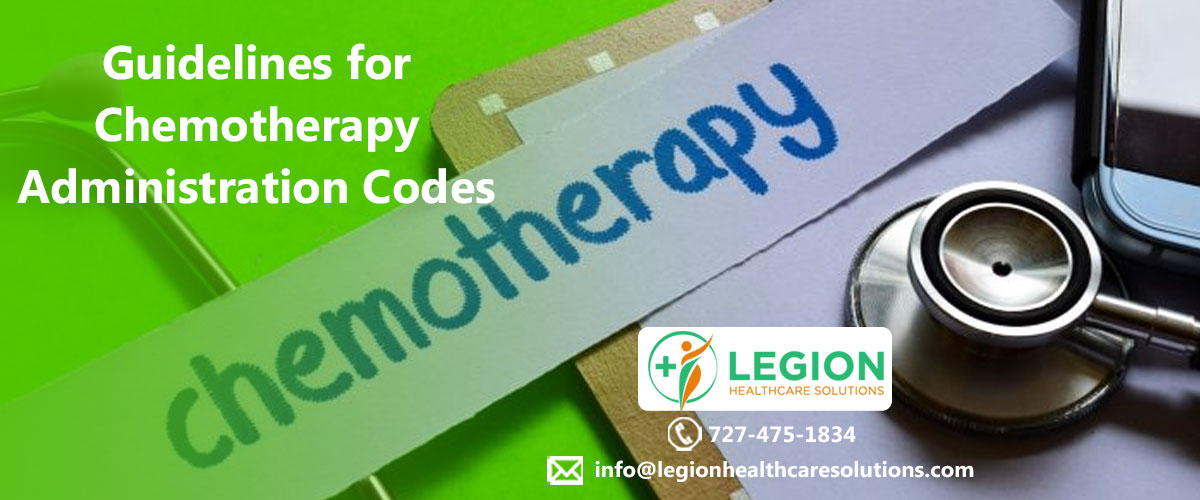
Guidelines for Chemotherapy Administration Codes
Basics of Chemotherapy Administration Codes
Before having detailed understanding about guidelines for chemotherapy administration codes, let’s define chemotherapy. Chemotherapy is a treatment of disease by means of chemical substances or drugs; usually used in reference to neoplastic disease. Procedure (CPT) code range 96401 to 96542, and 96549 cover chemotherapy administration. Medicare also identifies CPT codes 0662T and 0663T which are considered incidental to the professional charges for chemotherapy administration where no separate payment will be made. Services and items like use of local anesthesia; IV access; access to indwelling IV, subcutaneous catheter or port; flush at conclusion of infusion; standard tubing, syringes and supplies; and preparation of chemotherapy agent(s) are included chemotherapy and are not separately billable. Payment for the above is included in the payment for the chemotherapy administration service.
Chemotherapy administration codes apply to parenteral administration of non-radionuclide anti-neoplastic drugs; and also to anti-neoplastic agents provided for treatment of non-cancer diagnoses (e.g., cyclophosphamide for auto-immune conditions) or to substances such as monoclonal antibody agents, and other biologic response modifiers. Chemotherapy administration codes are used for services of a physician or qualified assistant employed by and under the supervision of a physician. Infliximab, rituximab, alemtuzumb, gemtuzumab, and trastuzumab drugs are commonly considered to fall under the category of monoclonal antibodies. Drugs commonly considered to fall under the category of hormonal ant-ineoplastics include leuprolide acetate and goserelin acetate.
Guidelines for Chemotherapy Administration (Non-chemotherapy Injections and Infusion Services)
- When administering multiple infusions, injections or combinations, the physician should report only one ‘initial’ service code unless protocol requires that two separate IV sites must be used. The initial code is the code that best describes the key or primary reason for the encounter and should always be reported irrespective of the order in which the infusions or injections occur.
- If an injection or infusion is of a subsequent or concurrent nature, even if it is the first such service within that group of services, then a subsequent or concurrent code should be reported. For example, the first IV push given subsequent to an initial one-hour infusion is reported using a subsequent IV push code.
- If more than one ‘initial’ service code is billed per day, the payer might deny the second initial service code unless the patient has to come back for a separately identifiable service on the same day or has two IV lines per protocol. For these separately identifiable services, instruct the physician to report with modifier 59.
- The CPT includes a code for a concurrent infusion in addition to an intravenous infusion for therapy, prophylaxis or diagnosis. Allow only one concurrent infusion per patient per encounter. Do not allow payment for the concurrent infusion billed with modifier 59 unless it is provided during a second encounter on the same day with the patient and is documented in the medical record.
- The physician may report the infusion code for ‘each additional hour’ only if the infusion interval is greater than 30 minutes beyond the 1 hour increment. For example if the patient receives an infusion of a single drug that lasts 1 hour and 45 minutes, the physician would report the “initial” code up to 1 hour and the add-on code for the additional 45 minutes.
- Several chemotherapy administration and non-chemotherapy injection and infusion service codes have the following parenthetical descriptor included as a part of the CPT code, ‘List separately in addition to code for primary procedure.’ Each of these codes has a physician fee schedule indicator of ‘ZZZ’ meaning this service is allowed if billed with another chemotherapy administration or non-chemotherapy injection and infusion service code.
- Do not interpret this parenthetical descriptor to mean that the add-on code can be billed only if it is listed with another drug administration primary code. For example, code 90761 will be ordinarily billed with code 90760. However, there may be instances when only the add-on code, 90761, is billed because an “initial” code from another section in the drug administration codes, instead of 90760, is billed as the primary code.
- If there is a visit or other chemotherapy administration or non-chemotherapy injection or infusion service provided on the same day, payment for 96523 is included in the payment for the other service.
- Coding team and physicians should follow the CPT coding instructions to report chemotherapy administration and non-chemotherapy injections and infusion services with the exception listed in subsection C for CPT code 90772.
Guidelines for Chemotherapy Administration and E/M Services Furnished on the Same Day
- Physicians providing a chemotherapy administration service or a non-chemotherapy drug infusion service and evaluation and management services (other than CPT code 99211), on the same day must bill using modifier 25.
- The insurance carrier might pay for evaluation and management services provided on the same day as the chemotherapy administration services or a non-chemotherapy injection or infusion service if the evaluation and management service meets the requirements of section §30.6.6 even though the underlying codes do not have global periods.
- If a chemotherapy service and a significant separately identifiable evaluation and management service are provided on the same day, a different diagnosis is not required.
While billing for chemotherapy note that,
- The administration of anti-anemia drugs and anti-emetic drugs by injection or infusion for cancer patients is not considered chemotherapy administration.
- When billing a dosage higher than that listed in the HCPCS Manual, use the units field to indicate a higher dosage. For example: The common dosage for J9070 is 100 mg. but 490 mg. was administered. Submit five units of service (round up the dosage).
- Professional charges 96360-96379 (infusion/injection services), 96521-96523 (pump refills/maintenance) and codes for chemotherapy administration codes 96401-96425 should not be submitted when services are administered in hospital or home setting.
- If a significant separately identifiable evaluation and management service is performed, the appropriate E & M code should be reported utilizing modifier 25 in addition to the chemotherapy code. For an evaluation and management service provided on the same day, a different diagnosis is not required.
Legion Healthcare Solutions is a leading medical billing company providing complete billing and coding services. We referred ‘Medicare Claims Processing Manual Chapter 12’ to discuss guidelines for chemotherapy administration codes. If you need any assistance in oncology medical billing and coding services, contact us at 727-475-1834 or email us at info@legionhealthcaresolutions.com
Get A Quote
[forminator_form id=”4528″]
